|
A Conversation with... James Dyson
In Three Parts...
--------------------------------------------
Page One -- Page Two -- Page Three
--------------------------------------------
James Dyson, design icon, inventor, and advocate, is at the forefront of design innovation and technology. He invented the bagless vacuum cleaner--employing cyclonic technology to spin out dirt at 100,000 G of centrifugal force--and has developed products that have achieved sales of over $10 billion worldwide. He has a long and distinguished career, fighting off copycats, fighting for intellectual property rights of designers, promoting design education, and contributing widely through various philanthropic pursuits.
Core77's Allan Chochinov had the opportunity to sit down with James Dyson at New York City's Terence Conran Shop, on the eve of the launch of Dyson's first U.S. product, the Dyson DC07 Vacuum Cleaner.
~
"It's a complete mistake--make it smoked or tinted or something."
C77: Most of your work, including your earlier projects, is charmingly concerned with quotidian acts: vacuuming the home, doing the laundry, moving dirt with a wheelbarrow. And I don't really know what question to ask you here, but I wonder if you've thought about this and have some insight.
JD: Well, it is an interesting point. I have done other things, like the landing craft, which was supplied to the military--and boats are sort of Cinderella products anyway. I've got some great memories and stories, and it was sort of a designer's dream, working on that sort of product. And that was lovely. But after five years of it, I actually longed to do something that I could use, a sort of everyday object. I did an electric wheelchair--putting the wheels on their sides where they form a segment of a much larger wheel--and because the wheels were laid on their side, it didn't look like a wheelchair; it didn't have the stigma of a wheelchair. So it was a great project to work on. But in some sense, it was worse than the boat, because with the boat, at least I could use a boat. And I sort of understood what it would be like for a soldier to wash off the boat, or for a diver to jump off the boat, or someone driving the boat, or what it's like to drive a vehicle onto the boat, or whatever. But the wheelchair, I couldn't understand at all; I was totally dependent on going and talking to people who live in wheelchairs, because they have a completely different view of what they find difficult, and what irritates them, where they get sores. For me then, I just felt separated from it, disaffected.
So I longed to do something that I used every day. And, of course, I'd been really stupid to ignore it, because you know as a designer or engineer, as soon as you see something, whether it's a vase or a cart, it's, "Why did they do that?" And so I was using the wheelbarrow at the house and I realized that it was pretty bad. The narrow wheel was stupid, and so on. I suddenly realized that what I should do then was follow my instincts. I use these products every day. I understand them. So therefore I'm in the position of the consumer, and don't need to do all this research; I'm the researcher.
But the really interesting point, I think, is that in order to change these things you've got to break all the existing rules and take a big risk. And I think if you use the product, and understand it yourself, you know you can do that. You know you're taking a risk and that you believe that you're right because you use it yourself.
Let me give an example from the vacuum cleaner, which is the clear bin.
C77: The clear bin?
JD: Yeah, seeing the dirt.
C77: I think it's fundamental to the product.
JD: Well, it is fundamental, but the interesting thing is that when I did this, all of our competitors just fell about the floor laughing; they were actually delighted that I'd been so stupid. And the retailers wouldn't have it. And when you saw the vacuum cleaners lined up in the stores, ready to demonstrate, you had this dirty bin with black dirt in it.
C77: I can imagine all the customers thinking, "Well, that's the demo. They made it clear in the store so we could see the technology, but the real one is opaque, right?"
JD: Well, Even we were worried. So we went into the stores, and our vacuum has all this shit in it. And the retailers are absolutely hostile. They say, "No, no, no, it's a complete mistake--make it smoked or tinted or something." But I persisted, because I found it really fascinating that you could see exactly what was happening; you could actually see the nature and texture and type of dirt you've picked up. But I wouldn't have got that from research, I'd have gotten the exact opposite.
"It's not a very good invention."
C77: Well, this gets to the topic of innovation. Do you think that it's a sort of bolt of lightning, or more homework, or more instinct?
JD: It's accident. Serendipity--but the serendipity that occurs through never giving up and through just going on and on and on, testing, searching new avenues. And going up many, many blind avenues!
C77: The Ballbarrow, though--surely that is an exception.
JD: Yeah, probably it is.
C77: Because at a certain point you look at it and you go, "oh." When I first saw the picture of the Ballbarrow, it seemed both inspired and obvious--that's how you know it's the right answer. So I'm assuming that it was more of a quantum leap than an iterative process that got you to the ball, right?
JD: It's pretty iterative! It's not a very good invention.
C77: Oh, it's not? It seems brilliant.
JD: Well, it's not really because it's simply a balloon tire. And I mean, balloon tires existed on vehicles (to take them across soft as opposed to hard ground.) So that's all I was doing. I mean the only fun of it, is that it is actually a ball. And the invention lay in making it very, very simple. The invention is not the ball itself, but rather in the bearings and the mounting for the ball; the way I fixed the ball to the barrow.
C77: And the patent on that?
JD: Well, exactly that point! Because the patent examiner said, "Here's a beach ball and here's a wheelbarrow, so what have you done that was invented?" So the patent was confined to the way you mounted the ball--which was useful, actually.
C77: And was that licensable, or leverageable to any other industries?
JD: Yes, we did a boat launching trolley using the balls. Some people made some sand yachts with them. We had a cricket wicket covers and a few other things, quite a lot of things we probably never even knew about.
"We don't actually employ any industrial designers."
C77: Let's talk about your design process for a minute, and how you work with your team of designers and engineers.
JD: Well, in the late '60s, early '70s, when I finished college at the Royal College of Art, one of the things I found worrisome was that if you were an industrial designer, you did the styling; if you were an engineer, you did the engineering; if you were a scientist, you did the R&D. And I looked at people like Buckminster Fuller, or Brunel, the Victorian engineer, or Andre Citroen in France--and here are people who did the R&D, the engineering and the design of the product all at the same time. And I could see that that's where my heart lay. And I used to go down to the industrial design section of the Royal College of Art and wander around, because I was in the architecture department. I'd wander around, and see these guys with their felt tip pens and their cases of peaches and things like that, and I found it pretty dull. There were no guts to it.
C77: Some people here call that type of work "skin-jobs."
JD: Yes, well, skin-jobs--I was trying not to be quite so rude! And I had observed that modern architecture was going to be about engineering, not bricks and concrete. And it occurred to me that that was pretty true of products as well. And that the age of decoration was over, and to a certain extent, the age of the Bauhaus--making everything into a black box, so you couldn't really tell the difference between a shaver and a tape recorder and a radio. I felt that such simple geometric minimalism was a suffocating and dull form of design. And I couldn't really see any interest in myself in being a stylist, doing skin jobs! So I put myself off to an engineering company to do R&D and to learn to be an engineer. And that's really how I started off life. I'm not saying that we have carbon copies of people like me at Dyson. But we don't actually employ any industrial designers. They're all engineers or scientists. Now, after I left college, 10 or 15 years later, the Royal College of Art and Brunel University started teaching engineers design.
I saw this as absolutely the way forward for product design or engineers; that the two shouldn't be separated. So actually, how we now work at Dyson is exactly how I worked, which is that the engineers develop the technology, engineer the product, and design it all themselves. They do the whole thing. Nobody comes along and says, "I'm the design expert," "I'm the engineering expert," or "I'm the R&D expert." We do have specialist scientists in that mix, but the main product people are engineers who've trained as designers. And we have one or two people who came to us through a slightly unconventional route, as artists or furniture designers.
C77: How many people are we talking about at Dyson?
JD: Three hundred engineers and scientists, out of a total of 1,200 people. But the engineers and scientists pick up design through osmosis--they certainly do if they're interested, as indeed most of them are. That's why they come here. And anyway, if you can go to college and in three years learn to be a designer, why can't you learn that pretty quickly at work?
C77: As the saying goes, "the first year of work is the fourth year of college."
JD: Yeah, actually it is. One of my sons came to work for us. He had done one year on the design course and then wanted to go off and be musician--which is what he's doing right now. But in the interim, he came to work for me, as an engineering designer. He hadn't done engineering or design, but he was doing what everybody else was doing, and picked it up pretty quickly. More...
Page One -- Page Two -- Page Three
|

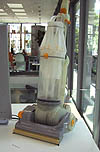
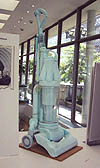
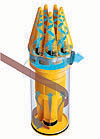


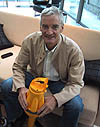


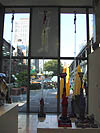
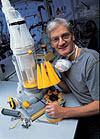


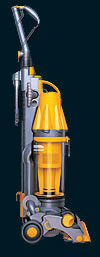
|



![]()













